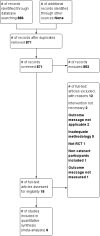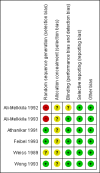Peribulbar versus retrobulbar anaesthesia for cataract surgery
- PMID: 26133124
- PMCID: PMC7175781
- DOI: 10.1002/14651858.CD004083.pub3
Peribulbar versus retrobulbar anaesthesia for cataract surgery
Abstract
Background: Cataract is a major cause of blindness worldwide. Unless medically contraindicated, cataract surgery is usually performed under local (regional) anaesthesia. Local anaesthesia involves the blockage of a nerve subserving a given part of the body. It involves infiltration of the area around the nerve with local anaesthetic. The two main approaches in the eye are retrobulbar and peribulbar. There is debate over whether the peribulbar approach provides more effective, safer anaesthesia for cataract surgery than retrobulbar block.
Objectives: The objective of this review was to assess the effects of peribulbar anaesthesia (PB) compared to retrobulbar anaesthesia (RB) on pain scores, ocular akinesia, patient acceptability and ocular and systemic complications.
Search methods: In the previous version of our review, we searched the databases until December 2007. In this updated version, we searched the Cochrane Central Register of Controlled Trials (CENTRAL) (March 2015); MEDLINE (1960 to March 2015); and EMBASE (1980 to March 2015).
Selection criteria: We included randomized controlled clinical trials comparing peribulbar anaesthesia and retrobulbar anaesthesia for cataract surgery.
Data collection and analysis: Two authors independently assessed trial quality and extracted data. We contacted trial authors for additional information, study methodology and missing data. We carried out a descriptive narrative of results as the included studies used varied methods for reporting the outcomes. We performed a subgroup analysis for globe akinesia.
Main results: We included six trials involving 1438 participants. Three of the six trials had adequate sequence generation while all the trials had unclear allocation concealment There was no evidence of any difference in pain perception during surgery with either retrobulbar or peribulbar anaesthesia. Both were largely effective. There was no evidence of any difference in complete akinesia or the need for further injections of local anaesthetic. Conjunctival chemosis was more common after peribulbar block (relative risk (RR) 2.11, 95% confidence interval (CI) 1.46 to 3.05) and lid haematoma was more common after retrobulbar block (RR 0.36, 95% CI 0.15 to 0.88). Retrobulbar haemorrhage was uncommon and occurred only once, in a patient who had a retrobulbar block.
Authors' conclusions: There is little to choose between peribulbar and retrobulbar block in terms of anaesthesia and akinesia during surgery measuring acceptability to patients, need for additional injections and development of severe complications. Severe local or systemic complications were rare for both types of block.
Conflict of interest statement
None known
Figures








Update of
-
Peribulbar versus retrobulbar anaesthesia for cataract surgery.Cochrane Database Syst Rev. 2008 Jul 16;(3):CD004083. doi: 10.1002/14651858.CD004083.pub2. Cochrane Database Syst Rev. 2008. Update in: Cochrane Database Syst Rev. 2015 Jul 02;(7):CD004083. doi: 10.1002/14651858.CD004083.pub3. PMID: 18646099 Updated.
References
References to studies included in this review
Ali‐Melkkila 1992 {published data only}
-
- Ali Melkkila TM, Virkkila M, Jyrkkio H. Regional anesthesia for cataract surgery: comparison of retrobulbar and peribulbar techniques. Indian Journal of Ophthalmology 1992;39:48‐9. [MEDLINE: ] - PubMed
Ali‐Melkkila 1993 {published data only}
Athanikar 1991 {published data only}
-
- Athanikar NS, Agrawal VB. One point low volume peribulbar anaesthesia versus retrobulbar anaesthesia a prospective clinical trial. Indian Journal of Ophthalmology 1991;39(2):48‐9. [MEDLINE: ] - PubMed
Feibel 1993 {published data only}
-
- Feibel RM, Custer PL, Gordon MO. Postcataract ptosis. A randomized, double‐masked comparison of peribulbar and retrobulbar anesthesia. Ophthalmology 1993;100:660‐5. [MEDLINE: ] - PubMed
Weiss 1989 {published data only}
-
- Weiss JL, Deichman CB. A comparison of retrobulbar and periocular anesthesia for cataract surgery. Archives of Ophthalmology 1989;107:96‐8. [MEDLINE: ] - PubMed
Wong 1993 {published data only}
-
- Wong HW, Koehrer E, Sutton HF. A modified retrobulbar block for eye surgery. Canadian Journal of Anaesthesia (Journal Canadien d'Anesthésie) 1993;40(6):547‐53. - PubMed
References to studies excluded from this review
Asensio 1994 {published data only}
-
- Asensio SVM, Sanchez BJ, Martin S, Merchan L. Comparison of retrobulbar and peribulbar anaesthesia for cataract surgery. Archivos de la Sociedad Española de Oftalmología 1994;66:171‐4. [MEDLINE: ]
Barker 1989 {published data only}
-
- Barker J P, Robinson PN, Vafidis GC, Hart GR, Hall GM. Local anaesthesia for cataract surgery. Lancet 1989;1:393. [MEDLINE: ] - PubMed
Edge 1995 {published data only}
-
- Edge KR, McClarty CP, Krige SJ, Rantalainan RR. Comparison of an extraconal block with a retrobulbar‐facial block combination for ocular surgery. South African Journal of Surgery 1995;33(3):117‐20. [MEDLINE: ] - PubMed
Hessemer 1994 {published data only}
-
- Hessemer V. Peribulbar anesthesia versus retrobulbar anesthesia with facial block. Techniques local anesthetics and additives, akinesia and sensory blockade, complications. Klinische Monatsblätter für Augenheilkunde 1994;204:75‐89. [MEDLINE: ] - PubMed
Jacobi 2000 {published data only}
-
- Jacobi PC, Dietlein TS, Jacobi FK. A comparative study of topical versus retrobulbar anesthesia in complicated cataract surgery. Archives of Ophthalmology 2000;118(8):1037‐43. [MEDLINE: ] - PubMed
Lavinsky 2000 {published data only}
-
- Lavinsky J, Gus PI, Ehlers JA, Roehe D, Nora DB. Visual‐evoked potentials: assessment of retrobulbar and peribulbar anesthesia. Journal of Cataract and Refractive Surgery 2000;26:1529‐32. [MEDLINE: ] - PubMed
Murdoch 1990 {published data only}
-
- Murdoch I. Peribulbar versus retrobulbar anaesthesia. Eye 1990;4:445‐9. [MEDLINE: ] - PubMed
Ramsay 2001 {published data only}
Ropo 1992 {published data only}
Sanford 1998 {published data only}
-
- Sanford D K, Minoso y de Cal OE, Belyea DA. Response of intraocular pressure to retrobulbar and peribulbar anesthesia. Ophthalmic Surgery and Lasers 1998;29:815‐7. [MEDLINE: ] - PubMed
Saunders 1993 {published data only}
-
- Saunders DC, Sturgess DA, Pemberton CJ, Morgan LH, Bourne A. Peribulbar and retrobulbar anesthesia with prilocaine: a comparison of two methods of local ocular anesthesia. Ophthalmic Surgery 1993;24(12):842‐5. [MEDLINE: ] - PubMed
Whitsett 1990 {published data only}
-
- Whitsett J C, Balyeat HD, McClure B. Comparison of one‐injection‐site peribulbar anesthesia and retrobulbar anesthesia. Journal of Cataract & Refractive Surgery 1990;16:527‐8. [MEDLINE: ] - PubMed
References to studies awaiting assessment
Agrawal 1993 {published data only}
-
- Agrawal K, Saxena RC, Nath R. Saxena S. Local anesthesia by peribulbar block for cataract extraction in an eye relief camp. Online Journal of Current Clinical Trials 1993;19:Doc No 40. [MEDLINE: ] - PubMed
Li 1996 {published data only}
-
- Li H, Li XE. Comparison of retrobulbar and periocular anesthesia for cataract surgery. Journal of Henyang Medical College 1996;24:49‐51.
Meyer 1992 {published data only}
-
- Meyer D, Hamilton RC, Loken RG, Bimbel HV. Effect of combined peribulbar and retrobulbar injection of large volume of anesthetic agents on the intraocular pressure. Canadian Journal of Ophthalmology 1992;27:230‐2. [MEDLINE: ] - PubMed
Sanders 1997 {published data only}
-
- Sanders R, Ahmed S, Craig EW, Young JD. Comparison of catecholmine and pressor effects in peribulbar and retrobulbar anaesthesia in cataract surgery. Eye 1997;11:644‐8. [MEDLINE: ] - PubMed
Additional references
Davis 1986
-
- Davis DB 2nd, Mandel MR. Posterior peribulbar anaesthesia: an alternative to retrobulbar anaesthesia. Journal of Cataract and Refractive Surgery 1986;12:182. - PubMed
Davis 1989
-
- Davis DB 2nd, Mandel MR. Posterior peribulbar anaesthesia: an alternative to retrobulbar anaesthesia. Indian Journal of Ophthalmology 1989;37:59‐61. - PubMed
Davis 1994
-
- Davis DB 2nd, Mandel MR. Efficacy and complication rate of 16,224 consecutive peribulbar blocks. A prospective multicentre study. Journal of Cataract & Refractive Surgery 1994;20(6):263. - PubMed
Foster 1999
-
- Foster A. Cataract ‐‐ a global perspective: output, outcome and outlay. Eye 1999;13:449‐53. - PubMed
Friedman 2001a
-
- Friedman DS, Bass EB, Lubomski LH, Fleisher LA, Kempen JH, Magaziner J, et al. Synthesis of the literature on the effectiveness of regional anesthesia for cataract surgery. Ophthalmology 2001;108(3):530‐41. [MEDLINE: ] - PubMed
Friedman 2001b
-
- Friedman SD, Bass EB, Lubomski LH, Flesher LA, Kempen JH, et al. The methodological quality of clinical trials on regional anesthesia for cataract surgery. Opthalmology 2001;108(3):530‐41. - PubMed
Fry 1990
-
- Fry RA, Henderson J. Local anaesthesia for eye surgery: the peribulbar technique. Anaesthesia 1990;45:14‐7. - PubMed
Hamilton 1988
-
- Hamilton RC, Gimble HV, Strunin L. Regional anaesthesia for 12,000 cataract extractions and lens implant procedures. Canadian Journal of Anaesthesia 1988;35:615‐25. - PubMed
Hansen 1998
-
- Hansen TE. Current trend in cataract surgery in Denmark; 1998 survey. Acta Ophthalmologica Scandinavica 1999;77:685‐9. - PubMed
Higgins 2009
-
- Higgins JPT, Green S, editors. Cochrane Handbook for Systematic Reviews of Interventions Version 5.0.2 [updated September 2009]. The Cochrane Collaboration, 2008. Available from www.cochrane‐handbook.org.
Leaming 1999
-
- Leaming DV. Practice styles and preferences of ASCRS members ‐ 1998 survey. Journal of Cataract and Refractive Surgery 1999;25:851‐9. - PubMed
RevMan 5.0 [Computer program]
-
- The Nordic Cochrane Centre, The Cochrane Collaboration. Review Manager (RevMan). Version 5.0. Copenhagen: The Nordic Cochrane Centre, The Cochrane Collaboration, 2007.
Springs 2001
-
- Springs CL, Broocker G. Injectional Orbital Anesthesia for Cataract Surgery. Survey of Ophthalmology 2001;46:181‐4. - PubMed
Publication types
MeSH terms
LinkOut - more resources
Full Text Sources
Other Literature Sources

